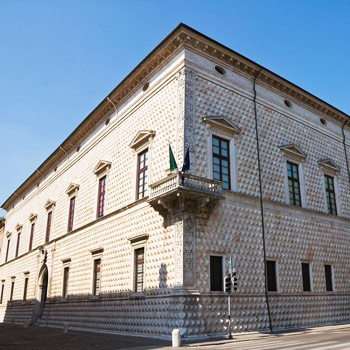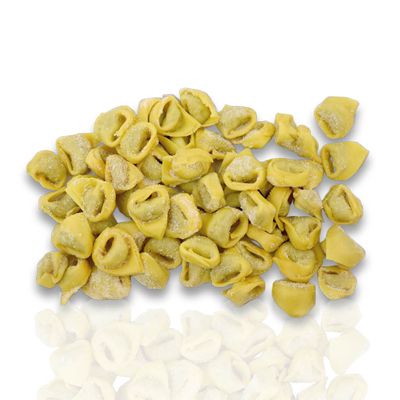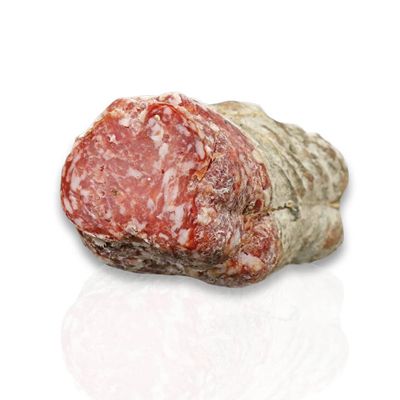The Palazzo dei Diamanti
 The Palazzo dei Diamanti in Ferrara is one of the main tourist attractions of the city, a building that, for the splendor and uniqueness of its structure, is considered one of the main and most representative buildings of the Italian Renaissance. The Palazzo dei Diamanti is a fundamental and indispensable stage of your tour of the city of Ferrara. The Palazzo dei Diamanti is also a stop on the tourist trail on bycicles, which you can find for rent in Ferrara Store, our typical products store in Ferrara, where we are waiting for you to taste our famous foods: our staff is always ready to help you in the search for the most interesting historical and artistic sites of the city.
The Palazzo dei Diamanti in Ferrara is one of the main tourist attractions of the city, a building that, for the splendor and uniqueness of its structure, is considered one of the main and most representative buildings of the Italian Renaissance. The Palazzo dei Diamanti is a fundamental and indispensable stage of your tour of the city of Ferrara. The Palazzo dei Diamanti is also a stop on the tourist trail on bycicles, which you can find for rent in Ferrara Store, our typical products store in Ferrara, where we are waiting for you to taste our famous foods: our staff is always ready to help you in the search for the most interesting historical and artistic sites of the city.
To understand the historical and artistic importance of the Palazzo dei Diamanti is necessary to refer to the urban renewal that took place during the late fifteenth century in Ferrara.
In 1484 Ercole I d'Este, after the war with Venice, decided to strengthen the walls of the city, entrusting the project to Biagio Rossetti (1447-1516), architect and great town planner, who also re-designed the urban fabric of the downtown, giving rise to what is called the Herculean Addition, an urban project that will take place from 1492 to 1510.
Rossetti will unite the city through two main orthogonal traffic arteries:
- The Street of the Angels, which ran from south to north, connecting the Port of the Angels with the Estense Castle;
- The Street of Prions and Equinoxes, which ran from east to west, connecting Porta Po to Porta a Mare.
The intersection of these two new arteries of the city center have given rise to the Crossroads of the Angels, in whose corners are located today three wonderful buildings promoted by the Este dynasty:
- Palazzo Prosperi-Sacrati;
- Palazzo Turchi di Bagno;
- Palazzo dei Diamanti.
The Palazzo dei Diamanti takes its name from the ashlar outside its walls, consisting of eight thousand five hundred blocks of white marble veined in pink, pointed faceted like the precious stone from which it takes its name: the diamond.
The Palazzo dei Diamanti was started in 1495 on behalf of Sigismondo d'Este, brother of the Duke Ercole I d'Este: the design of the Palazzo dei Diamanti was again entrusted to Biagio Rossetti. Rossetti’s idea was to place the Palazzo dei Diamanti in the Crossroads of the Angels to erect a stylistically graceful building, that would stand at the center of the Herculean Addition. The processing of the marble of the Palazzo dei Diamanti was entrusted to the stonemasons Gabriele Frisoni from Mantua and Christopher from Milan. The ashlar on the four walls of the Palazzo dei Diamanti is presented visually as a set of small jutting pyramids, wisely arranged in staggered rows so as to give a graceful and non-monotonous vision of the exterior walls of the Palazzo dei Diamanti, where vibrant shadows are created by sunlight at different times of the day. As well, in the ashlar of the Palazzo dei Diamanti, all the slits between a block and the other have been carefully removed, in such a way as to give the impression of the facade of the building as a single block of marble, in which the diamonds were carved.
Gabriele Frisoni also worked on the grotesque candelabra with plant motifs in the corners of the Palazzo dei Diamanti, connecting elements between the various rows of small pyramids.
 Inside the Palazzo dei Diamanti, which is arranged in a horseshoe shaped plan, there is a cloister at the center of which a well of marble was placed, typical element of the cloisters built during the Renaissance in Ferrara.
Inside the Palazzo dei Diamanti, which is arranged in a horseshoe shaped plan, there is a cloister at the center of which a well of marble was placed, typical element of the cloisters built during the Renaissance in Ferrara.
Historically, the Palazzo dei Diamanti in Ferrara has not undergone major structural changes such as to upset the original project; only in 1641, with the sale of the Palazzo dei Diamanti by the Este to the Villa family, candelabra will be added to the sides of the entrance of the palace.
Since 1842, the Palazzo dei Diamanti is owned by the Municipality of Ferrara, purchased to become the home of the Art Gallery and of the University of the city, as well as to set up important art exhibitions that attract visitors from around the world.
- READ MORE
Today, the Palazzo dei Diamanti hosts:
- The Municipal Gallery of Modern Art, located on the ground floor; it’s a very important gallery of national and international relevance, within which you can see temporary exhibitions of modern art, where the protagonists are the best Italian and foreign artists (Morandi, Turner, Miro, just to name a few);
- The Picture Gallery, located on the noble floor of the Palace.
Inside the Picture Gallery you will find works of absolute importance as:
- Christ with the Virgin Mary, (1462), tempera on panel by Andrea Mantegna;
- Erato, tempera on panel, (1450-60), Angelo Maccagnino;
- The Judgment of San Maurelio, oil on panel, (1480) by Cosme Tura;
- Madonna and Child, tempera and gold on wood, (1400) by Gentile da Fabriano;
- Urania, tempera on panel, (1450) by an anonymous ferrarese painter.
Ferrara Store offers you a very efficient staff, willing to point you to the major attractions of the city of Ferrara that you cannot miss during your tour of the city, such as the Estense Castle, the Diamond Palace and the Walls of Ferrara.
The territory of Ferrara, in addition to art and history, offers you traditional foods of the highest quality like pampepato, the wine of the eliceo forest, the garlic of Voghiera, the coppia ferrarese, the pumpkin flatbread, the pumpkin cappellacci and the salama da sugo; you can find all these products in our store, we ensure the best typical products of Ferrara that you can find in our city.










